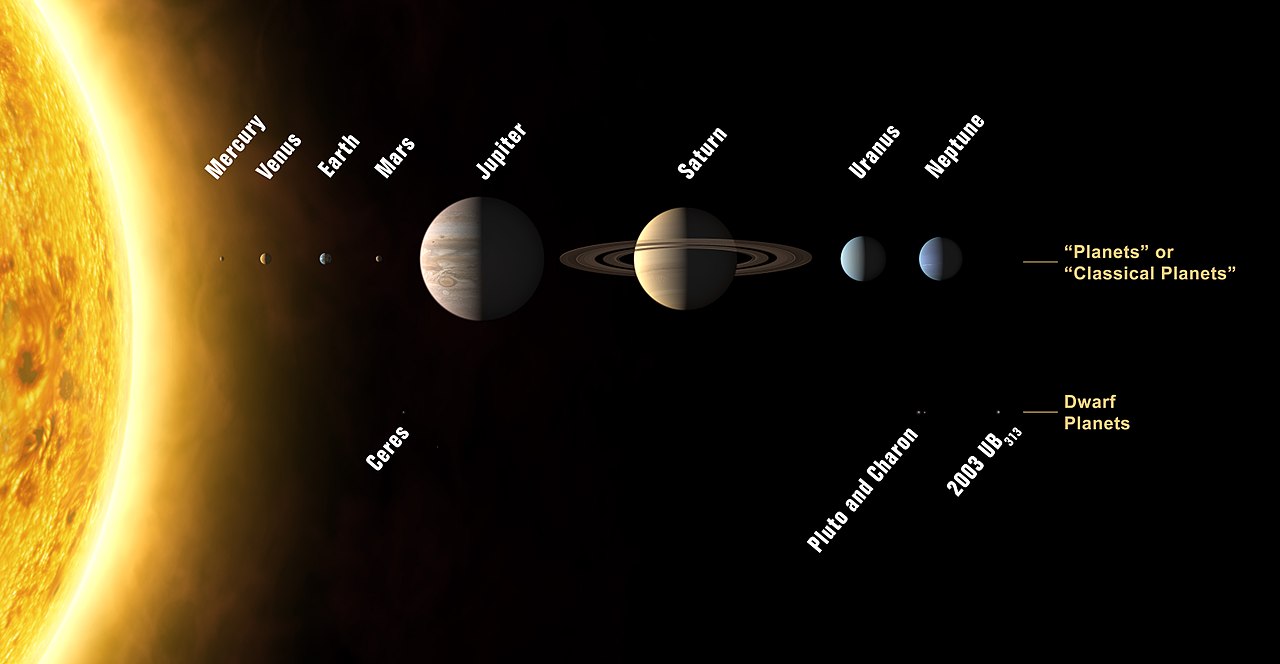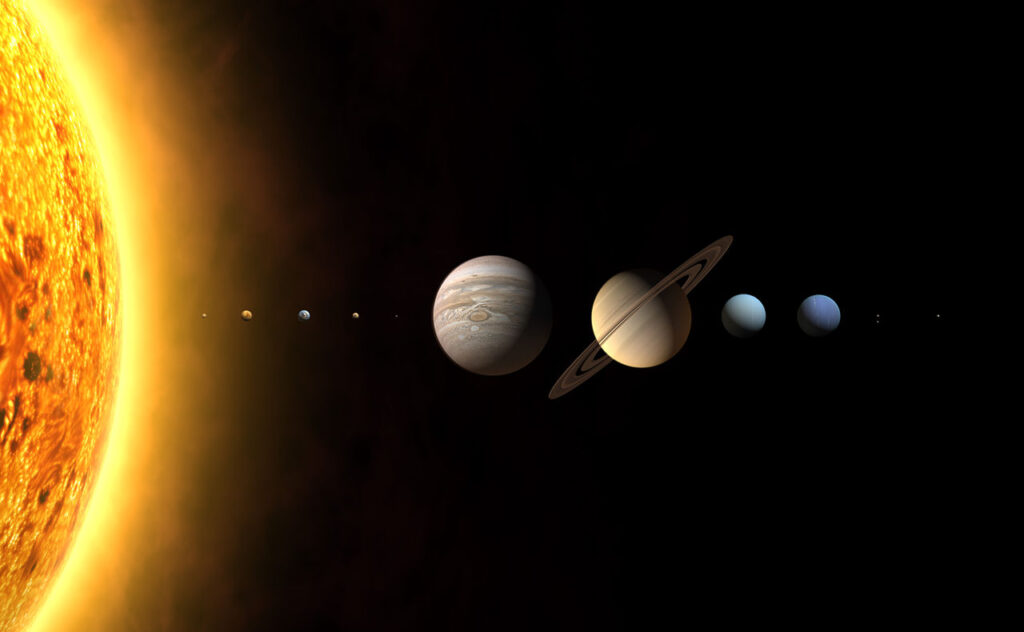The formation of the solar system
The most recognized theory behind the formation of the solar system among astronomers is the so-called nebula theory, which explains the formation of the solar system as follows:
- Nebula: A large rotating cloud of gas and dust known as the ‘solar nebula’ emerges (approx. 4.5 billion years ago)
- The plate shape: As the large nebula collapses due to its gravity, it rotates faster and faster, resulting in it taking on a flat “saucer” shape
- The formation of the sun: Most of the material in the cloud is pulled towards the center and forms the sun
- The formation of planetesimals: Other particles collide (inside the “saucer”) and are thus assembled into so-called ‘planetesimals’, which are objects up to about 1 km in diameter
- The formation of planets, moons, etc: Some of these planetesimals later become asteroids, comets, moons and planets
- Inner planets: The planets in the inner solar system get their characteristic rocky surfaces because the solar winds are so strong that they blow away most of the lighter elements (such as hydrogen and helium), leaving only the small rocky planets
- Outer planets: The solar winds lose their power as they move out into the solar system, leaving the plants in the outer solar system as gas giants consisting mainly of hydrogen and helium

Fact: This is our solar system
The structure of the solar system
The individual parts of the solar system’s structure are discussed here. The structure of the solar system can be quickly outlined as follows:
Sun – Mercury – Venus – Earth – Mars (asteroid belt) – Jupiter – Saturn – Uranus – Neptune – (Kuiper belt incl. Pluto) – (Oort cloud) – (heliosphere)
The individual elements are discussed in more detail below:
- The planets of the solar system: Our solar system consists of 8 planets (Mercury, Venus, Earth, Mars, Jupiter, Saturn, Uranus, Neptune) and 5 dwarf planets (Ceres, Makemake, Haumea, Eris, Pluto) as well as thousands of asteroids and comets
- Asteroids: Most asteroids in our solar system are located between the planets Mars and Jupiter’s orbit and are simply called the ‘asteroid belt’
- Experts estimate that the asteroid belt between Mars and Jupiter contains more than 750,000 asteroids with a diameter of 1 km or more, as well as millions of smaller asteroids and meteorites (rocks)
- Some of the asteroids have orbits that occasionally cause them to collide with Earth or other planets in the inner solar system
- Comets: The majority of comets in the solar system are further away from Earth than Pluto and are found in the Kuiper Belt and the Oort Cloud
- Comets in the solar system are mainly made up of ice and rock. As a comet approaches the sun, some of the ice in its nucleus melts and turns into gas; and it is this gas that makes up the characteristic “tails” of comets
- Comets are divided into short- and long-lived comets; short-lived comets complete their orbits in less than 200 years and are thought to originate from the Kuiper Belt, while long-lived comets complete their orbits in over 200 years and probably come from the Oort Cloud
- Inner Solar System: The 4 planets closest to the Sun – Mercury, Venus, Earth and Mars – are so-called ‘rocky planets’ (also called rocky planets, terrestrial planets or terrestrial planets) because they all have solid rocky surfaces. These planets are also called the ‘inner solar system’
- Outer solar system: The 4 largest planets farther from the sun than Mars – i.e. Jupiter, Saturn, Uranus and Neptune – are so-called ‘gas giants’ (also called gas planets or Jovian planets) because they do not have a solid surface, but instead consist primarily of gas. These planets are also called the ‘outer solar system’
- The planets in the outer solar system are primarily composed of hydrogen and helium, making their composition very similar to that of the sun. Some scientists believe that the planets may have solid cores. In addition, they have rings containing dust, rock and ice. These elements vary greatly in size; from dust grains to blocks the size of a house
- Saturn has the largest and most prominent rings among the planets in our solar system – but Jupiter, Uranus and Neptune also have rings
- Magnetic fields: Most planets in our solar system have magnetic fields surrounding them (a so-called ‘magnetosphere’). The sun also has a magnetic field (the heliosphere) that incorporates our entire solar system
- Moons: Almost all of the planets in our solar system – and some of the moons – have atmospheres. However, the chemical substances found in the individual atomic spheres vary a lot, and the behavior of the atmospheres (due to differences in the planets’ orbits) is also diverse. For example, Pluto’s atmosphere collapses when Pluto orbits far away from the sun. The atmosphere recovers as the planet approaches the sun. This phenomenon is mostly seen in comets
- There are 166 known moons in our solar system. However, this number only includes moons of recognized plants, therefore excluding the moons of Pluto, for example
- The Kuiper belt: The Kuiper Belt is located about 50 AU (50 x Earth’s distance from the sun) from the sun – following Neptune’s orbit – and extends 30-35 AU further out into the solar system. The Kuiper Belt likely contains hundreds of thousands of icy objects more than 100 km wide and over 1 trillion comets (or more)
- The ear cloud: The Oort Cloud is located about 50,000 AU from the sun and can theoretically extend 5,000-100,000 AU out into the solar system. The Oort Cloud contains up to 2 trillion icy objects and a very large number of comets. It should be noted that the Oort cloud has never been observed
- Heliosphere: After the Oort cloud comes the end of the solar system, the ‘heliosphere’, which is the sun’s huge teardrop-shaped magnetic field that surrounds the entire solar system and is made up of electrically charged particles. Many astronomers believe that the heliosphere’s distance to the sun is around 15 billion kilometers from the sun


